Warships. Cruisers. Almost flawless chevalier
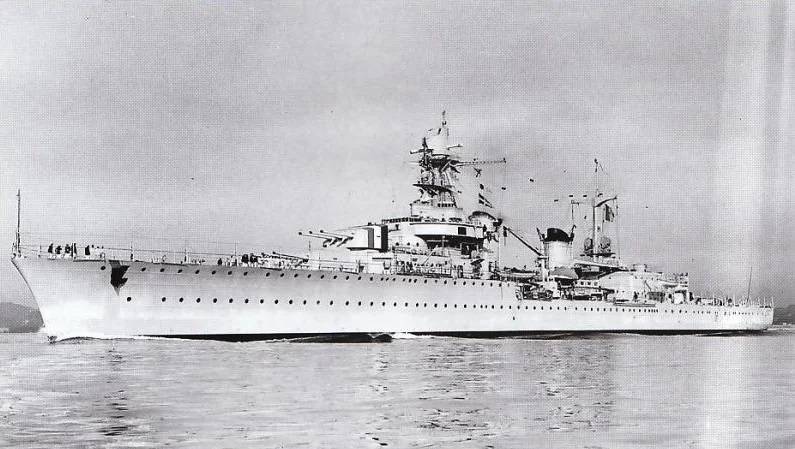
The first half of the 20th century between the two wars is truly an interesting time from the point of view of marine engineering stories. When a turning point occurred in the minds of the designers, and then it was still reinforced by the Washington kick, then very interesting ships began to appear.
Although I still believe that, had it not been for Washington, our military history would have taken a completely different path. And perhaps this path would be more progressive than the one that we traveled, swam.
World War One died out. According to its results, France and Italy were in a very interesting position. Italy suddenly became a steep regional power after the collapse of Austria-Hungary, and France, on the contrary, fell to this level, since the British clearly commanded the Atlantic after the war and there was nothing for the French to catch there.
There remained the Mediterranean Sea, where both countries tried to realize their ambitions. Both countries did not succeed with the dreadnoughts and battlecruisers (in particular), and the fleets took a very original shape.
Both the French and Italians hastily set up a rather impressive number of destroyers, destroyer leaders, and destroyers. And since the ships built had to be fought, both sides came up with projects for light and fast cruisers with 150 mm artillery.
In the previous article, we examined the "Emil Bertin", which became a test ball for the French, and the Italians got the "Condottieri" project, which will be ahead of us.
Politically, all this looked very strange, because in the First World France and Italy were like allies, and in the Second ... In the Second World War, too, did not work out. Moreover, this confrontation looked very funny if it were not so sad. And, nevertheless, it (confrontation) gave rise to many beautiful and really good ships.
So we will start from the thirties, when they spat on battleships and battlecruisers, the French and Italians built very nice cruisers. And we’ll talk about the next step after Emil Bertin.
So, by the 30s of the last century, there was a picture: a fast and not very armored cruiser with 150-mm guns, capable of catching up with the destroyer and explaining the truth of life to it. Inexpensive, technological so that you can build in series. But the main thing is inexpensive.
The experiment with Emil Bertin, on the one hand, cannot be considered successful. On the other hand, light appeared at the French shipbuilders at the end of the tunnel, that is, they understood in which direction to move.
And as a result of this movement in the ranks of the French fleet 6 new cruisers of the La Galissonier type joined. We planned 7, but the Chateau Renault was not ordered, the Washington restrictions played a role.
What is La Galissoniere? This is Emil Bertin, who has passed through thoughtful work on bugs. We'll talk about TTX a little lower, but for now it’s worth noting that the cruisers turned out, and turned out even more powerful than the Italian. At least one trunk of the main caliber of the French was more, 9 against 8.
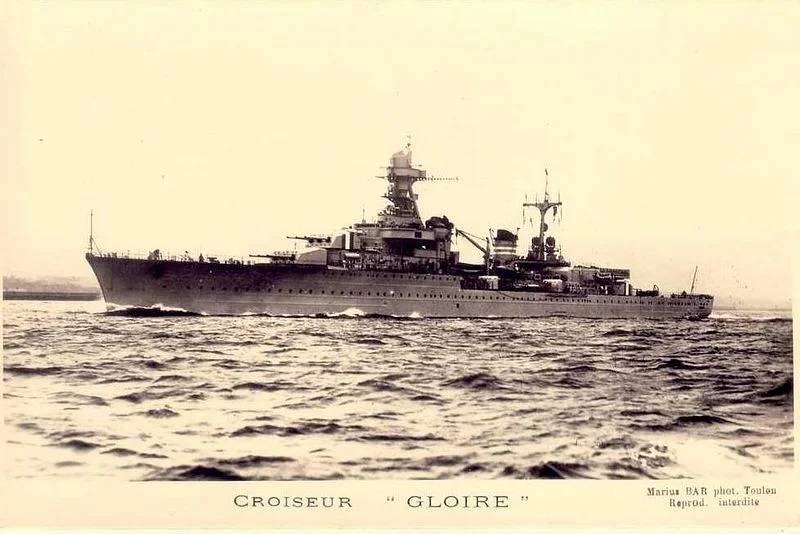
The series came out very patriotic, judging by how the names of the ships were chosen.
"La Gallisonier" - in honor of Roland-Michel Barren de La Galissoniere, winner of the Battle of Menorca in 1756. The battle was, so to speak, not entirely unambiguous, but it is believed that the British were hung in it.
"Jean de Vienne" - in honor of the admiral of France Jean de Vienne. The admiral was very restless, he fought his whole life against the whole world, he died in the battle of Nikopol (Bulgaria) in the battle with the Turks in 1396.
Georges Leig - in honor of a politician of the Third Republic
Moncalm - in memory of Louis Joseph de Montcalm-Gozon, Marquis de Saint-Veran, commander of the French troops in North America during the Seven Years War.
"Marseillaise" - clear, the anthem of France.
Gluar - “Glory.”
In general, it is very bright and patriotic, but let's see what the ships were like in terms of characteristics.
Displacement. Standard - 7600 “long” tons, full - 9100 dt. The ship is noticeably “thicker” than Emil Bertin.
Length 172 m. Width 17,48 m. Draft 5,1 - 5,35 m. That's just for the not deepest Mediterranean Sea, it turned out very well. It was possible to safely go even to the Adriatic, where the deep sea did not pamper.
Armor. It's luxurious here, the armor, unlike its predecessor, simply was. Good, bad - it WAS!
Belt - 105 mm.
Traverses - from 20 to 60 mm.
Deck - 38 mm.
Barbets - from 75 to 95 mm.
Towers - from 50 to 100 mm.
Chopping - from 50 to 95 mm.
Reservation is not anti-fragmentation, it could very well reflect a 120-130-mm destroyer shell, if you're lucky. Of course, it’s not good news that the figures, but not a complete absence, as in “Emil Bertin”, agree.
Engines 2 TZA from Parsons (classic), or exotic, but their own Rateau Bretagne. Both the first and second gave out about 84 liters. sec., which provided a speed of 000 knots. Let’s put it this way: not only excellent, but enough.
Cruising range of 7000 nautical miles cruising at 12 knots. For the Mediterranean - well, more than. Without refueling from Toulon to Latakia - completely.
The crew of 540 people. In wartime, with the increase in emergency teams and air defense crews - up to 675 people.
Armament.
The main caliber is 9 152 mm guns in three towers, two on the bow and one on the stern.
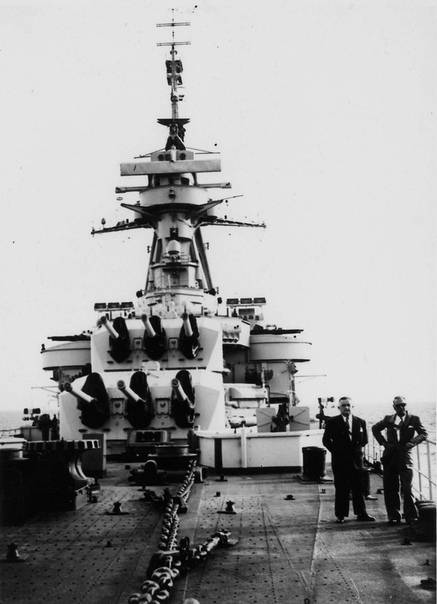
Auxiliary universal caliber - 8 universal 90-mm guns in four towers. Plus 4 coaxial machine gun mounts from "Hotchkiss" 13,2 mm caliber. As modest as that of Emil Bertin.
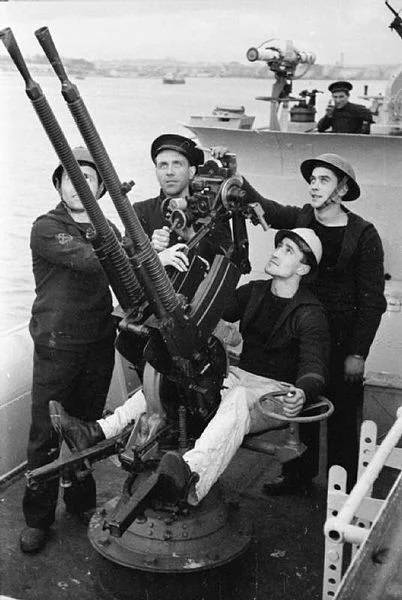
Mine-torpedo armament was represented by two twin-tube 550-mm torpedo tubes.
Aviation group - 1 catapult, 2 seaplanes. Aircraft could be taken up to 4, but in disassembled form.
About seaworthiness. The cruisers failed. They were all very moving and not subject to vibrations at high speeds, over 30 knots. All as one, the ships easily kept the estimated speed of 31 knots, but if you really need it, you could get more.
So, in tests, "La Galissoniere" issued 35,42 knots. “Marseillaise” - 34,98 knots, and the fastest was “Gluar”, which showed a maximum speed of 36,93 knots.
Tests confirmed the cruising range of the cruisers, all fit into the calculated data.
More about weapons.
The main caliber artillery was completely repeating the "Emil Bertin". 152,4 mm M1930 shell loading guns were located in towers of the "Marine-Omkur" type 1930 model.
Two towers were located in the bow of the cruisers, linearly elevated, the third in the stern. The bow towers had firing angles of 135 ° on board, the stern - 145 °.
The guns were placed in individual cradles and had vertical guidance angles from −7 ° to + 45 ° for the bow and stern towers and from −10 ° to + 45 ° for the elevated bow tower. The guns were loaded at an angle of inclination of the barrel from −5 ° to + 15 °.
Guiding the towers was carried out remotely, using electric drives. The practical rate of fire is 5-6 rounds per minute per barrel. The maximum rate of fire was shown by the “Gluar” at firing in 1938 - 9 rounds per minute on the barrel. Of course, the real combat rate of fire was much lower, in the region of 2-4 rounds per minute.
In general, in terms of the main caliber, everything was pretty confident and modern.
Flak. The same 90 mm M1926 guns as on the Emil Bertin with the same problems.
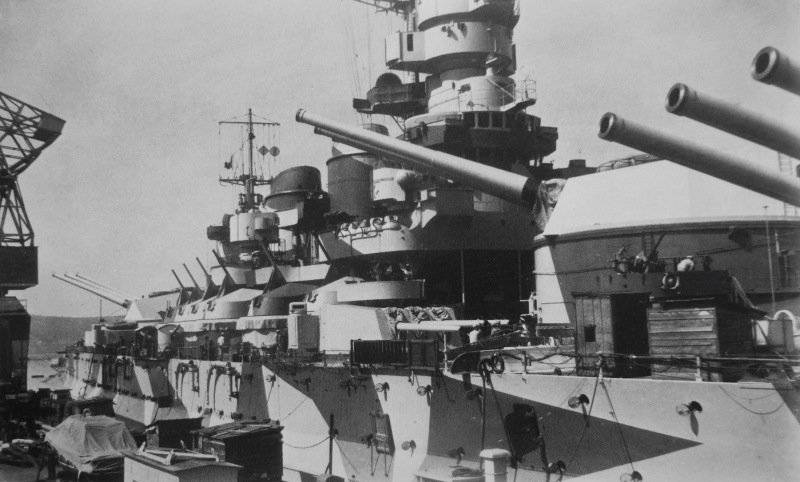
On the one hand, a semi-automatic shutter and an automatic rammer, which were unitary, theoretically gave a rate of fire up to 15 rounds per minute. However, at elevation angles of more than 60 °, loading problems started and the rate of fire dropped significantly. In general, as a means of air defense 90 mm universal guns were not very good.
But each cruiser carried eight of these guns in twin units, protected from fragments by shields of 5 mm thickness. Placed the installation is also not very successful. As the anti-mine caliber, the 90-mm guns were quite, but not very anti-aircraft, since practically the bow and stern of the ship were outside the firing zones.
Anti-aircraft fire control of 90-mm guns was carried out remotely, from two command-range posts. The shooting data was generated by two sets of 1930 anti-aircraft fire control devices using two 3-meter rangefinders. In practice, the system proved to be unreliable, and the shooting was carried out autonomously, which, as you know, did not add efficiency at all.
The only plus was the ability (theoretical) to fire 90 mm guns at two different targets or directions.
With small-caliber anti-aircraft artillery, everything was still sad since Emil Bertin. The promised 37 mm automatic anti-aircraft gun was never mastered, so I had to plug the hole with the same 13,2 mm Hotchkisses.
And so, this machine gun was not a masterpiece armory thoughts, and with food from 30-cartridge stores, it was really terrible. But not for enemy pilots, but for their calculations. So four paired installations of these machine guns can not be considered a good solution, but alas, there was nothing else.
In general, at the beginning of the war, the air defense of cruisers could not even be considered satisfactory.
Armor. The numbers above are numbers, but the armor wasn’t just there, but by booking the “La Galissoniers” they could become standards in the class. The Germans were always famous for their smart booking location, the British tried to take thick. It turned out something in between, and it seems like they did not stint on steel, and placed it very smartly. The so-called practice of variable thickness played a role, making the cruiser very protected ships, while not greatly increasing the weight of the ship.
But, I repeat, unlike Emil Bertin, the builders were not greedy here, and as a result, the total weight of the armor was 1460 tons or 24% of the standard displacement of the ship.
The main armored belt was 105 mm thick, but 60 mm were made to the bottom. In the bow and stern, the width of the armored belt was reduced by 2 meters, but with the same thickness. Behind the armored belt on the sides were armored bulkheads with a thickness of 20 mm. These bulkheads served as anti-torpedo (weak) and anti-shatter protection.
On top of the citadel was closed from fragments of armored deck with a thickness of 38 mm.
The main caliber towers, unlike their predecessor, were very good. No wonder the mass of one tower "La Galissonier" weighed 172 tons, while the "Emil Bertin" - 112 tons.
The thickness of the frontal part of the tower was 100 mm, the side - 50 mm, the back - 40 mm, the roof had a thickness of 50 mm. The barbets of the towers were also well armored, above the deck the thickness of the armor was 95 mm, below the deck 70 mm.
The conning tower was also booked quite impressive. Again, in comparison with Emil Bertin, where the thickness of the cabin was as much as 20 mm. At La Galissonier, the cabin was protected along the perimeter with 95 mm armor, a roof of 50 mm, a floor of 25 mm.
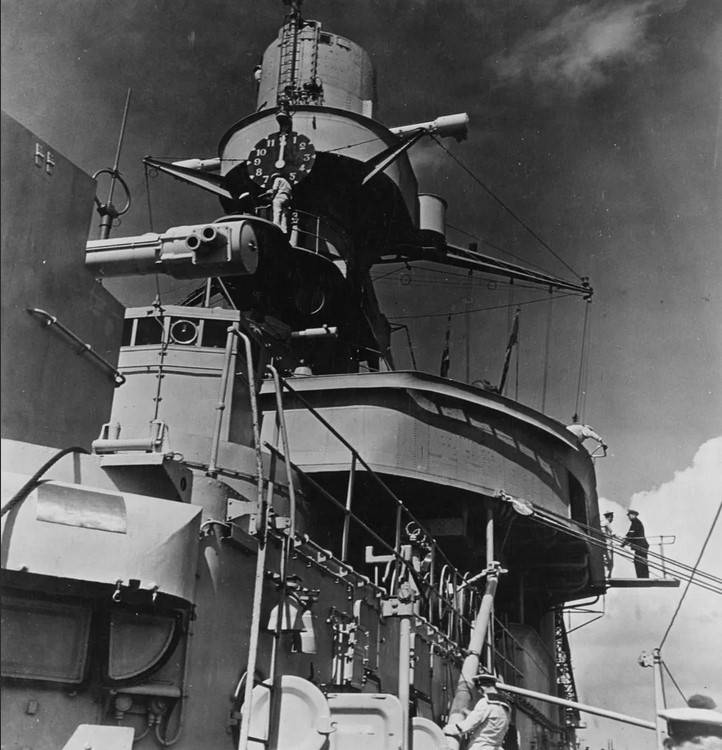
The conning tower was connected to the central post by an armored passage with a wall thickness of 45 mm. Chimneys (26 mm), ventilation shafts (20 mm), and a steering machine (26 mm) were also protected.
Compared to Emil Bertin, a very good armored monster was obtained. Before the war, military experts saw the La Galissoniers as ideal light cruisers.
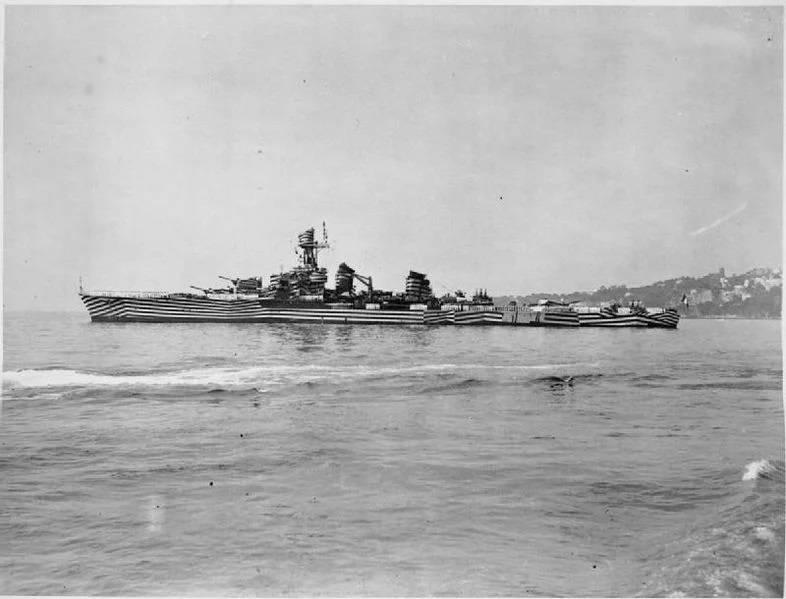
I must say, for their displacement, these were very balanced ships, very equally combining both combat and navigational qualities. But the main advantage was the price. For such a low cost, very worthy cruisers were obtained.
Of course, there were some shortcomings. There were two main, or rather, one and a half. Half can be considered the French Rato turbines, which were not reliable, respectively, the cruisers that were equipped with these turbines instead of the Parsons had problems with them.
The second problem was air defense. The inability to install normal anti-aircraft guns made the cruiser virtually defenseless in the near air defense zone. Any more or less serious air attack could be fatal for ships.
It can be said that La Galissonieres were lucky, and they did not have to meet with real air attacks in the initial period of the war. And those who survived this period, after modernization received quite decent “Erlikons” and “Bofors”, which made the air defense of ships more or less acceptable.
Six cruisers entered the war. But there was a date that divided the ships into two parts. On November 27, 1942, in the fire and flame went to the bottom of La Galissonier, Jean de Vienne and Marseillaise, whose crews complied with the order to destroy the ships so that the Germans would not get them.
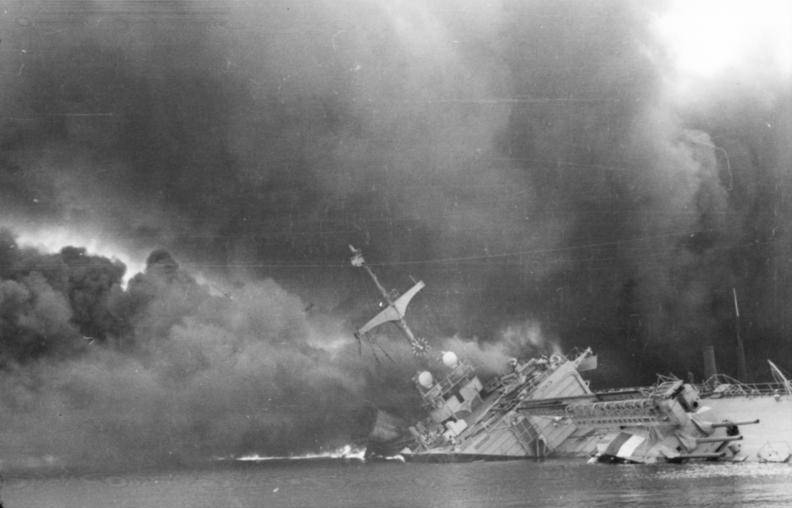
Heroic, but very inglorious death.
And La Galissonier was sunk twice.
After the surrender of France, “La Galissonier” as part of the 3rd cruiser division was included in the “Compound of the High Seas”, formed on September 25, 1940 from the most combat-ready ships of the fleet and based on Toulon and the Mediterranean. The activity of this compound was extremely limited due to lack of fuel.
November 27, 1942 “La Galissoniere” was in Toulon, at dock number 3. The ship had an incomplete crew, but the rest of the crew managed to flood the cruiser right in the dock.
Despite the fact that the Germans declared all French ships confiscated, Italians were able to take part of the ships under their control, inspect and proceed with the rise.
The Italians were strong in lifting and repairing ships. The La Galissoniere, which was raised on March 9, 1943, was among those suitable for lifting. The cruiser was to be transferred to Italy for repair and restoration, the date of departure was called July 11, 1943. However, thanks to the frank sabotage of the French dockers, the ship was never able to go to sea. September 9, 1943 Italy entered into a truce with the Allies, but the ships still remained in Toulon.
On August 31, 1944, the La Galissonier was sunk during a raid by American B-25 bombers and sank at a depth of 10 m.
In 1945, “La Galissoniere” was raised, but recognized as unsuitable for restoration. On December 13, 1946, the cruiser was expelled from the fleet and dismantled in 1956.
"Jean de Vienne."
November 27, 1942 "Jean de Vienne" was in Toulon, in dock number 1. The crew flooded his ship right in the dock, where he sat almost on an even keel. They also had to blow up the ship, but something did not grow together.
It is clear that the Italians raised such a gift in the first place. The cruiser was raised on February 18, 1943 and he was also to be sent to Italy. However, the cruiser in Toulon left sabotage until August 24, 1943, when two bombs from American bombers sent him to the bottom of the harbor.
On November 27, 1945, the cruiser was raised, on December 13, 1946, the cruiser was expelled from the fleet, and in 1948 its remains were sold for scrap.
The Marseillaise.
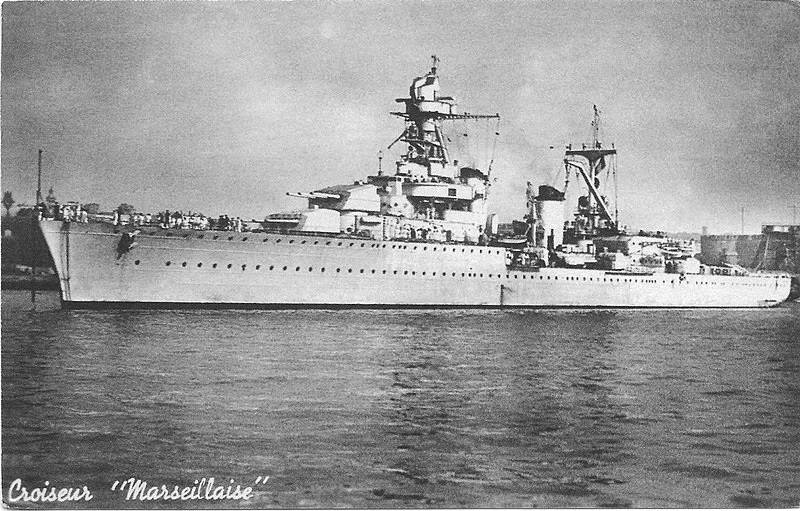
On November 27, 1942, the Marseillaise was in Toulon. Having received the command to destroy the ship, the crew activated the subversive charges that destroyed the ship.
The remains of the ship were raised after the war and in 1946 sent for scrapping.
"Georges Leig."
He escaped death in Toulon, leaving together with the Gluar and Moncalm in Dakar. The British tried to put a paw on the ships, sending a detachment of ships to intercept. The Georges Leig and Moncalm broke through, with the Leig commanders planting two shells in the Australian heavy cruiser Australia. The Gluar was brought down by domestic turbines, and he returned to Casablanca.
September 23-25, 1940 "Georges Leig" participated in the defense of Dakar against the British fleet. Together with Moncalm, he maneuvered on the outer raid of Dakar, firing at British ships. On September 24, Georges Leig made two hits with the main caliber in the battleship Barham, but did not cause serious damage.
In 1941-42, the cruiser patrolled in the Mediterranean Sea, as part of the French squadron, based on Dakar. He mastered the profession of a gold carrier, transporting about 100 tons of French gold from Dakar to Casablanca.
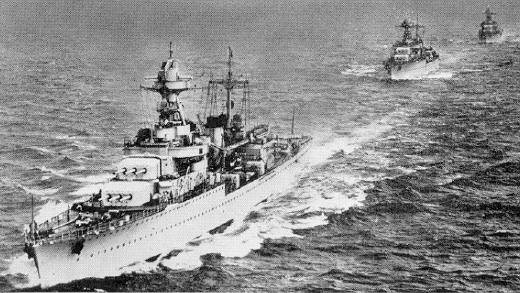
In 1943, after France spoke on the Allied side, the cruiser went to Philadelphia, where the catapult, hangars, aircraft were dismantled, and instead installed anti-aircraft installations of 20 and 37 mm.
The cruiser patrolled in the Atlantic, opposing German submarines and raiders, supported the landing of the Allied forces in Normandy, in September 1944 the cruiser again began to be based on Toulon.
The last battle in World War II was the artillery support of the landing in the area of Genoa in March 1945.
After the war ended, the cruiser took part in hostilities more than once. After modernization in Casablanca in 1946, Georges Leig, together with Moncalm, took part in the fighting in Indochina in 1954.
And in 1956, in the Suez crisis, as part of a group of French ships, it provided fire support to Israeli troops operating in the Gaza Strip.
December 17, 1959 the cruiser Georges Leig was expelled from the fleet and sold for scrap.
Gluar.
At the time of the surrender of France from the war, the Gluard was in Algeria. In June 1940, the ship returned to Toulon. In September, he participated in an attempt to break into the Atlantic, opposing the attempt to capture ships by the British.
Due to a turbine breakdown, the cruiser did not get to the designated point Libreville, but was forced to return to Casablanca, where it was being repaired until March 1941, after which it moved to Dakar.
During the spring and autumn of 1941, the Gluar took part in a number of convoy operations of the French fleet in the Atlantic. Subsequently, due to lack of fuel, ships based in Dakar rarely went to sea for a long time, but in March-April 1942 the Gluar transported 75 tons of gold from Dakar to Casablanca.
In September 1942, the cruiser took part in the rescue of the crew and passengers of the British liner Laconia, sunk by a German submarine. During the search operation, the Gluar took on board, and then delivered 1041 people to Casablanca.
Since the beginning of 1943, the cruiser participated in patrol operations in the Central Atlantic. During 1943, the "Gluar" made 9 ocean voyages for this purpose. He visited modernization at the end of 1943 in New York. The modernization was similar to that carried out at Georges Leigue - the aircraft equipment was removed, the small-caliber anti-aircraft artillery was installed.
In February 1944, the Gluar appeared in the Mediterranean Sea, where it provided fire support to the British ground forces fighting at Anzio in Italy. After landing, the cruiser transported British troops from North Africa to Naples.
In August 1944, the Gluard took part in the landing of the Allies in southern France, supporting fire landing operations.
The combat service of the cruiser ended in 1955, and in 1958 it was sold for scrap.
Moncalm.
With the outbreak of World War II, Moncalm became part of the Raider formation, based on Brest, which was involved in escorting convoys and hunting for German raiders. As part of the compound, he participated in the escort of two convoys and chased the Scharnhorst and the Gneisenau in the North Sea.
In 1940 he covered the evacuation of the Allies from Norway.
Returning back, he made the transition to Dakar, since by that time Brest was in the hands of the Germans. He took part in the defense of Dakar from the British fleet.
In 1943, it underwent modernization in Philadelphia, after which, as part of an allied formation, it participated in landing operations in Corsica, in southern France and Normandy.
After the end of World War II, he participated in the 1954 war in Indochina, and suppressed anti-French riots in Algeria in 1957.
It was used by the Navy until the end of 1969 and in May 1970 ended its journey, was sold for scrap.
As you can see, those ships that did not come under destruction in Toulon lived a rather long and meaningful life. Moreover, not as training ships, floating barracks or targets, but as full-fledged (well, almost full-fledged) warships.
It is clear that in the 60s these cruisers, even equipped with modern radars, could be used exclusively against the countries of the third or fourth world. But they were used, which testifies to their quite decent combat potential.
Of course, everything is known by comparison, and therefore in one of the following materials we will deal precisely with the comparison of cruisers of the La Galissonier type with their direct competitors. That is, with the Italian cruisers of the Kondotieri type A, B and C.
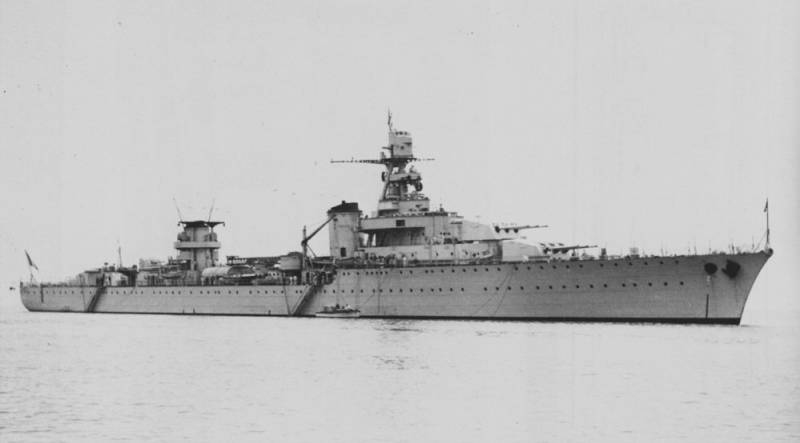
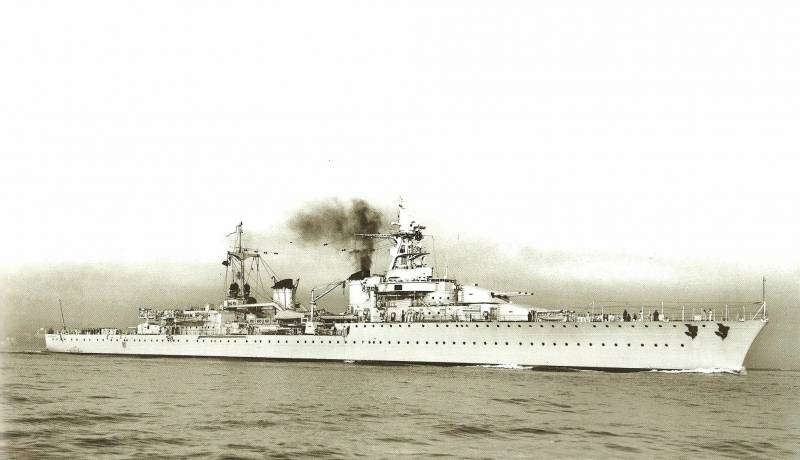
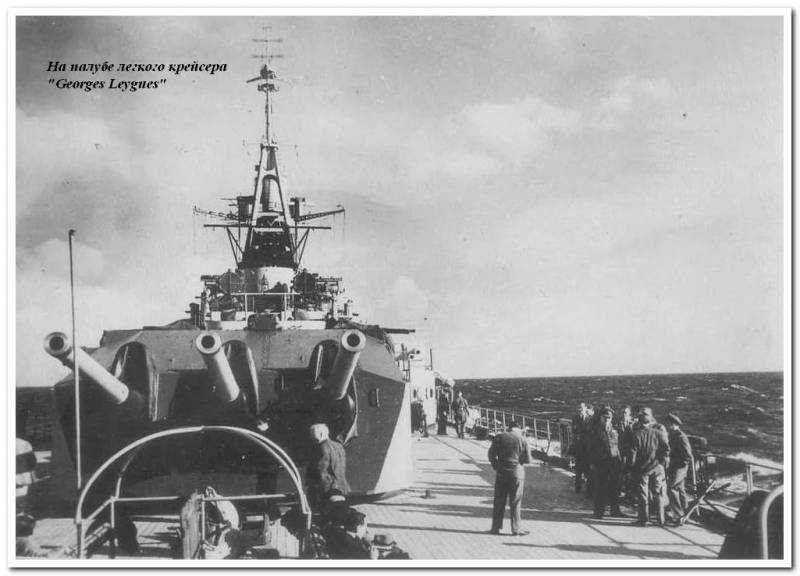
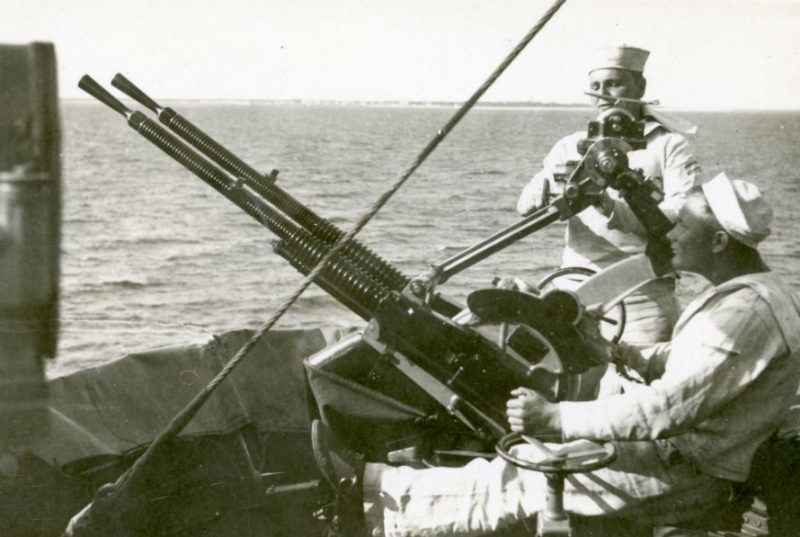
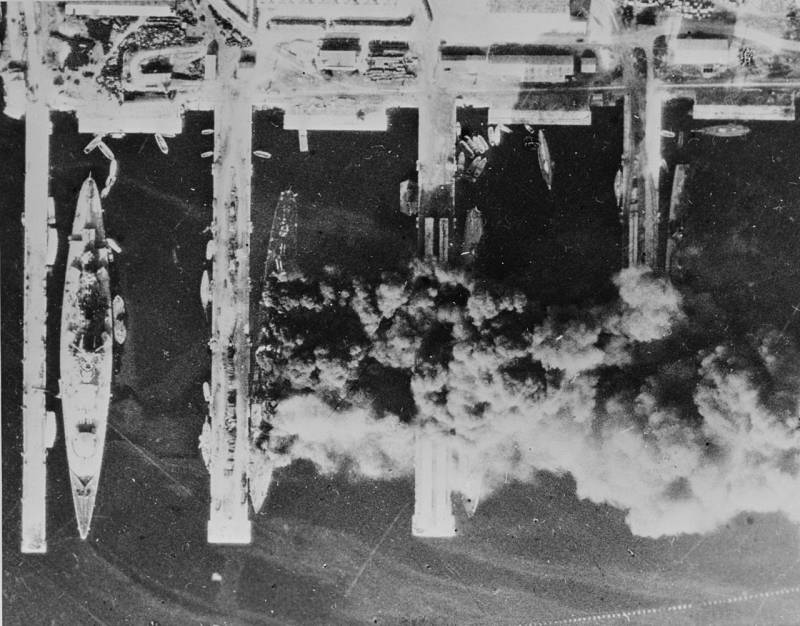
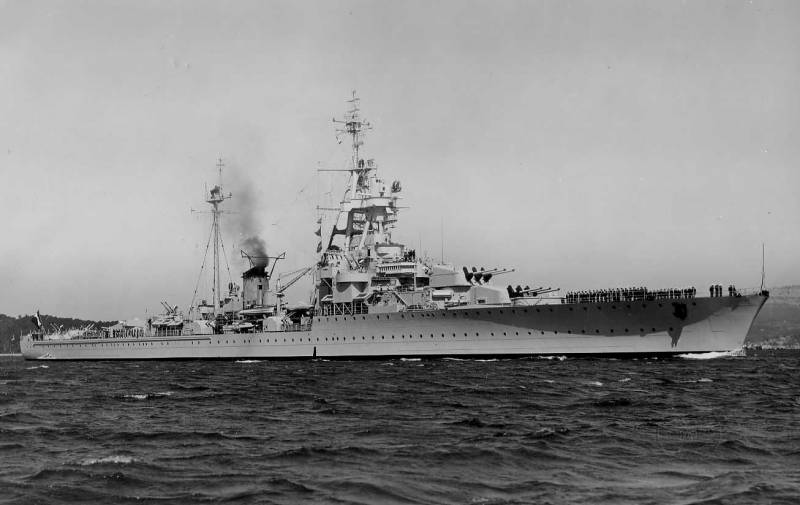
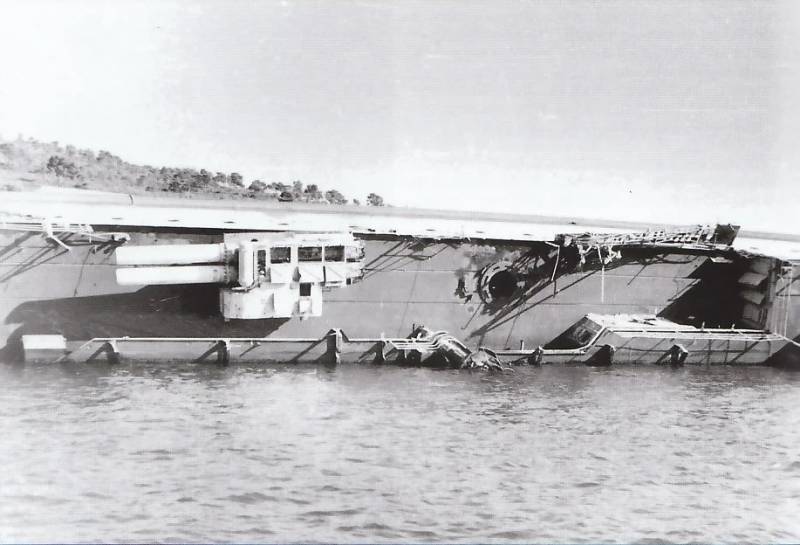
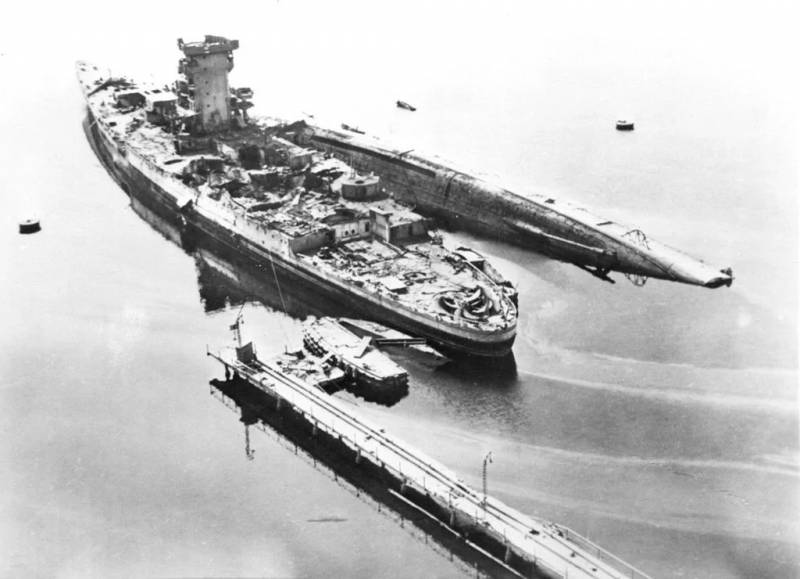
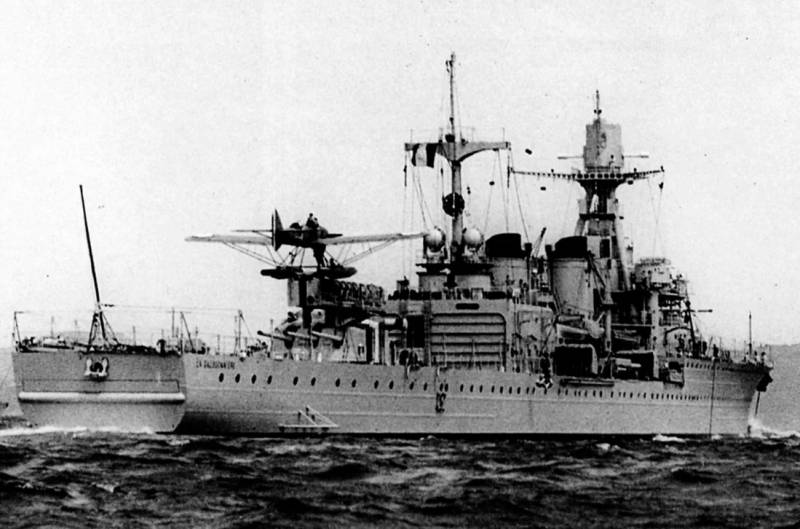
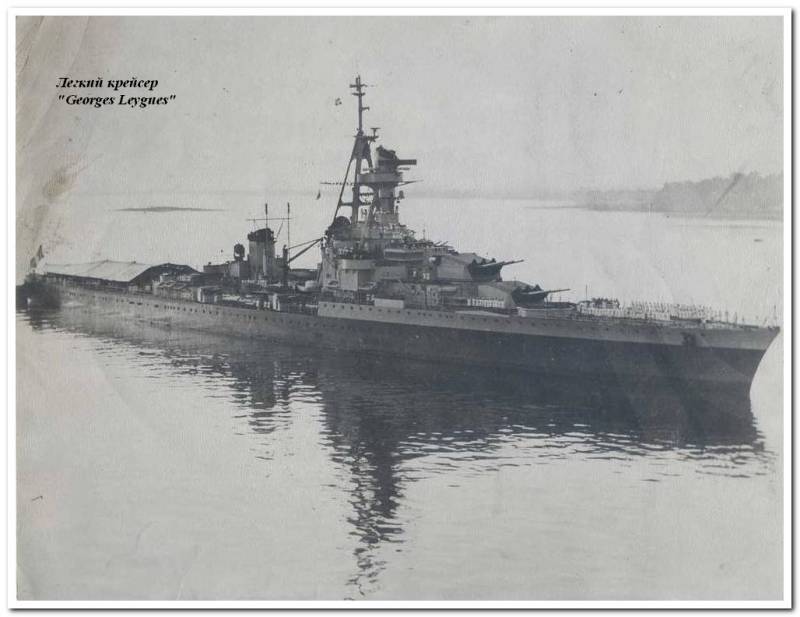
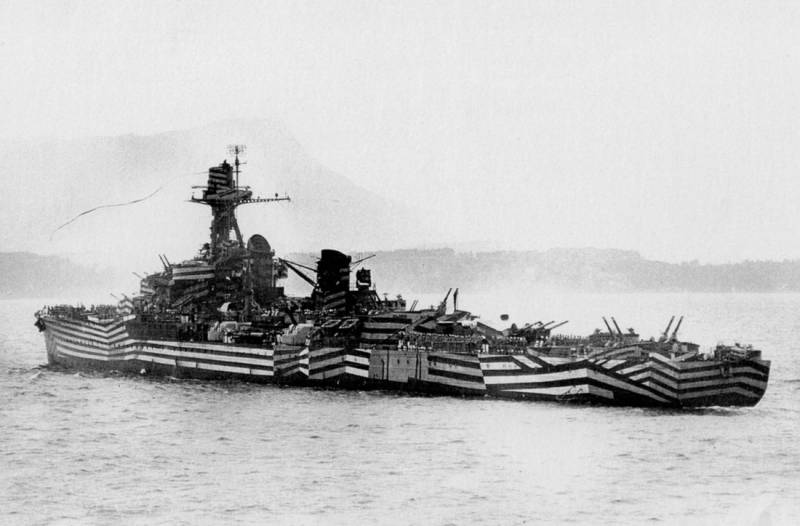
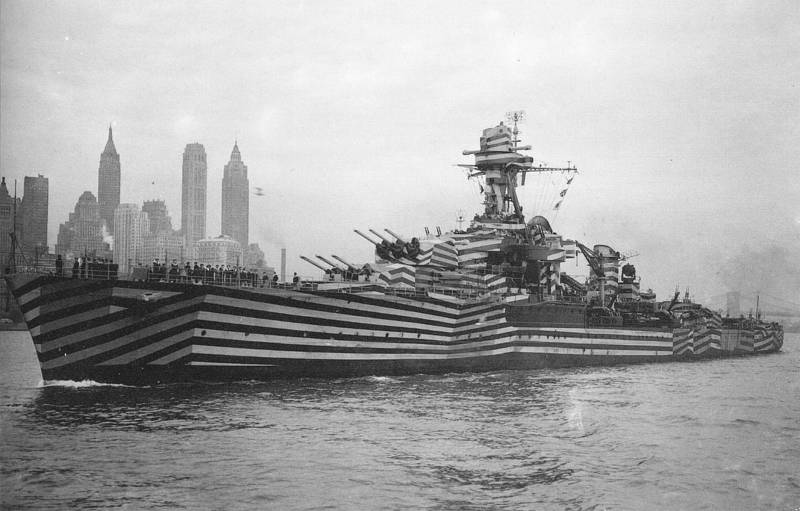

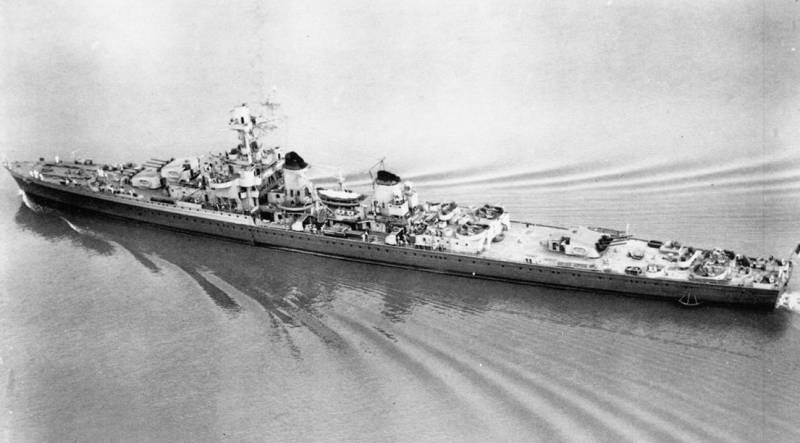
Information